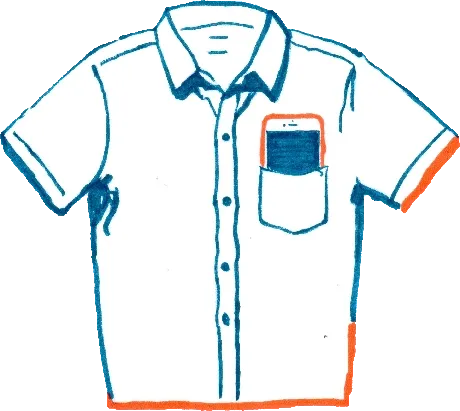Pocket-Sized Productions
Simple tips for creating low-maintenance video content

Pocket-Sized
Production
Simple Tips for Creating
Low-Maintenance Video Content

We probably don't need to tell you that video is one of the most popular ways to consume and share information. But video is more than that—it's also a tool for marketing your schools. In fact, a 2023 study found that 87% of private sector marketers say video has a direct impact on increasing sales. When it comes to experiential marketing, video plays a big role in generating buzz around your events.
Creating great video content may seem intimidating, but it doesn’t have to be. In fact, there are several different easy, low-budget ways to create amazing videos. To explore this idea, we sat down with SchoolCEO’s award-winning, in-house video producers, Ryan McDonald and Tanner Cox, to talk to them about all things video. Together, they have over 25 years of experience in film, cinematography, TV production and video content creation. Here’s what they shared.
Anyone can create good videos with a smartphone.
It’s easy to assume that to get good video content, you need state-of-the-art equipment—but that’s not necessarily true. If a smartphone is all you have to work with, that’s more than enough.
“People overestimate what they really need,” says Cox. “If you have a smartphone, you can basically do anything you need for content creation purposes. Obviously, the more money you have, the better photo and video quality you have. But if you have a smartphone, there’s your mic, there’s your camera. It has really good lighting detection and depth,” says Cox. So if you’re working with a limited marketing budget, don’t stress. You’ve got everything you need right in your pocket.
People won’t listen to poor audio.
Visual quality matters, but sound is arguably the most important factor in video production. “There’s a saying I used to hear: ‘People will watch bad videos, but they won’t listen to bad audio,’” says Cox. “So to get better sound in your videos, try using a small clip-on mic where the audio records directly to your device, like a smartphone.”
Shoot videos horizontally, then crop them.
As you probably know, some communication channels—like Instagram reels—work best with vertical videos, while others favor a horizontal format. When gathering content, some people like to shoot a mix of vertical and horizontal videos at events to use, but shooting the same video in two different formats can be tedious. Luckily, there’s an easy solution: Film your video horizontally, and then crop it during the editing process to create a vertical version.
“Film horizontally at 4,000-pixel resolution, then crop it to get your vertical video, or even still shots,” says McDonald. Say you want to shoot a video for your website but you’d also like to share it on Instagram. First, shoot the video horizontally for your website. Then, crop the video to 1,080 pixels to get a vertical version for Instagram.
For good lighting, all you need is a window.
Lighting is another important part of video creation, but what do you do if your lighting options are limited? The key is to find a natural light source, like a window.
“Work with windows, not against them,” says McDonald. “You generally want to make sure you’re not shooting against a window or bright light source, and you don’t want to directly face your subject toward a window either. Position them so that the light hits the side of their face, like a 45-degree angle,” This can help soften someone’s face and add an extra element of depth and dimensionality in the frame. It also adds a little bit of reflection in the eye. “You see that a lot in professional photography—these little glints in people’s eyes,” McDonald says. “It makes a person look more alive, and it’s more visually interesting.”
Prep your subjects, but leave room for spontaneity.
Most people feel uncomfortable on camera—at least at first—but a little preparation can go a long way. “The way you talk to the person beforehand is important,” says Cox. “The more information they have going into a shoot—when they have a better idea of what it’s going to look like, the vibe of the video—the more they’ll stop trying to be perfect. So be honest and transparent with them about what you’re making.”
That being said, sometimes a little spontaneity makes for more authentic, organic content. “Actually, I will start rolling when people don’t know,” says McDonald. “People will usually ask when we’re starting, and I’ll say we’re already rolling. That usually loosens them up because they realize, Oh, I’ve already been on camera for 30 seconds, and everything is fine.”
Take advantage of free video editing resources.
Post-production video editing can be the most intimidating part of the process if you’re not a professional videographer. But luckily, you don’t need fancy software to make your videos look amazing. For beginners looking to post on social media, there are several free tools available. According to McDonald and Cox, CapCut is becoming a popular choice because of its auto-captioning features, text-to-speech voiceover tools and an easy drag-and-drop user interface.
“DaVinci Resolve 19 is another free tool for those wanting to add some extra polish and pizzazz to their videos,” Cox adds. “It has more of a technical learning curve, but it’s a great option for those wanting to take their video editing skills to the next level.” When it comes to video editing software, it’s important to remember that the internet is your friend. If you encounter a problem while working in any video editing tool, it’s likely that someone somewhere has had the same problem and posted their solution on YouTube or on online forums, like Reddit.
Adaptability is key.
As school communicators, keep in mind that not every idea you have will be the best one, but any content you gather can be molded into whatever you need. “I recently finished a video with four different endings. None of them worked,” says Cox. “The final ending came after revisions. You just have to be flexible.”
Sometimes the best ideas come last. “I think the harder you stick to something instead of adapting and pivoting your idea, the worse the video turns out to be,” Cox reflects. “Part of that, again, is adapting to the moment, being fluid, and withholding frustration—even if you need 20 takes to get there.”

